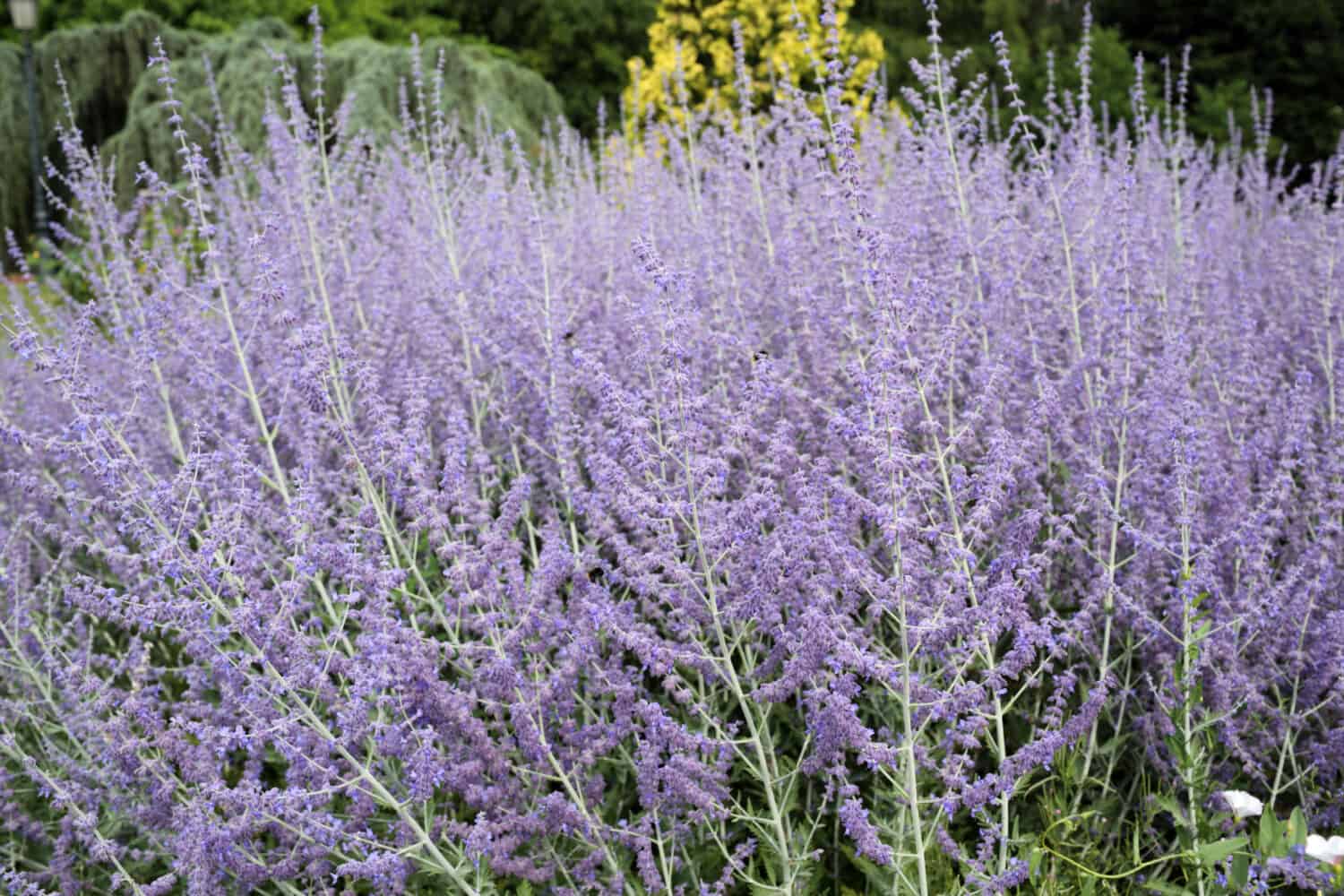If you’re a Wyoming resident with a hankering for vibrant blooms that come back year after year, you’re in for a treat. In this article, we’re diving headfirst into the captivating world of perennial flowers that thrive in the rugged beauty of Wyoming’s landscape.
1. Pigsqueak
The pigsqueak flower is a charming perennial that boasts broad, shiny leaves and delicate blooms. Its rounded leaves, resembling large cabbage leaves, grow close to the ground in attractive clusters. The flowers stand on tall stalks above the foliage, displaying shades of pink, purple, or white in a bell-like shape.
Native to regions in Asia, pigsqueak flowers have found a welcoming home in various parts of Wyoming due to their adaptability. These hardy plants thrive in colder climates. They are well-suited to the challenging conditions of Wyoming’s weather, characterized by cold winters and short growing seasons. The pigsqueak’s ability to tolerate cold temperatures, its resistance to drought, and its preference for well-drained soil make it a suitable choice for Wyoming’s diverse landscapes.
In Wyoming, pigsqueak flowers can be found in gardens, borders, and rocky slopes. They add a touch of color and texture to the landscape. Their ability to endure harsh conditions while still producing attractive flowers and foliage makes them a popular choice for gardeners looking for plants that can withstand the challenges of Wyoming’s environment.
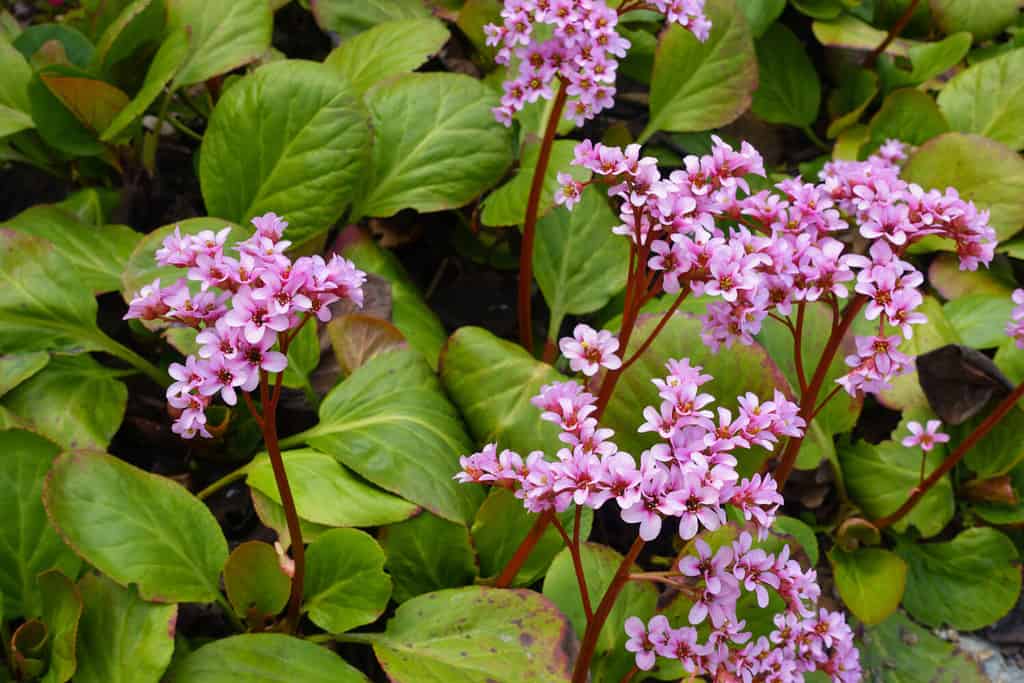
Pigsqueak is also known as the bergenia plant.
©Elena Terletskaya/Shutterstock.com
2. Periwinkle
The periwinkle flower is a dainty perennial appreciated for its simple yet captivating beauty. Its glossy, evergreen leaves form a dense carpet. It boasts delicate, five-petaled blossoms that come in shades of blue, purple, or white. These charming flowers exhibit a star-like shape and often sport a contrasting eye in the center.
Native to Europe, periwinkle has found a comfortable niche in the diverse landscapes of Wyoming. Its adaptability to various soil types and its capability to thrive in both sun and shade contribute to its success in this region. The flower’s ability to spread quickly helps control soil erosion on slopes, making it a favored choice for landscaping.
In Wyoming, periwinkle flowers can be spotted in gardens, along borders, and in woodland settings. The state’s mix of climates, from arid to mountainous, is well-suited to this hardy plant’s preferences. Its resistance to deer browsing and its low-maintenance nature make it an appealing option for gardeners seeking reliable and attractive ground cover.
The periwinkle flower’s endurance through cold winters and its resilience against various challenges align well with Wyoming’s demanding environment, making it a popular choice for those seeking a touch of color and vibrancy in their outdoor spaces.

Periwinkle flowers can vary in color but will always retain their unique pinwheel-like shape.
©Dewi Cahyaningrum/Shutterstock.com
3. Foxglove Beardtongue
The foxglove beardtongue flower is an elegant perennial renowned for its unique appearance. Sporting tall spikes adorned with tubular blossoms, this flower showcases shades of white or pale pink with delicate speckles and lines, resembling intricate brushstrokes. The open, bell-shaped flowers create a charming contrast against its prominent, hairy stamens, giving it the name “beardtongue.”
Native to North America, the foxglove beardtongue flourishes in the diverse landscapes of Wyoming. It can be found in meadows, prairies, and open woodlands, often making appearances in both dry and moderately moist soils. Its adaptability to different soil types and its ability to tolerate periods of drought contribute to its success in Wyoming’s varied climate.
The flower’s ability to attract pollinators, such as bees and hummingbirds, further adds to its appeal. Its tall spikes create vertical interest in gardens and natural settings. Also, its low maintenance requirements make it a favorable choice for both novice and experienced gardeners.
In Wyoming, where the climate can be challenging, the foxglove beardtongue’s resilience to cold temperatures and its adaptability to varying conditions make it a reliable and eye-catching addition to landscapes. Its unique appearance and ability to thrive in diverse environments contribute to its popularity in gardens throughout the state.
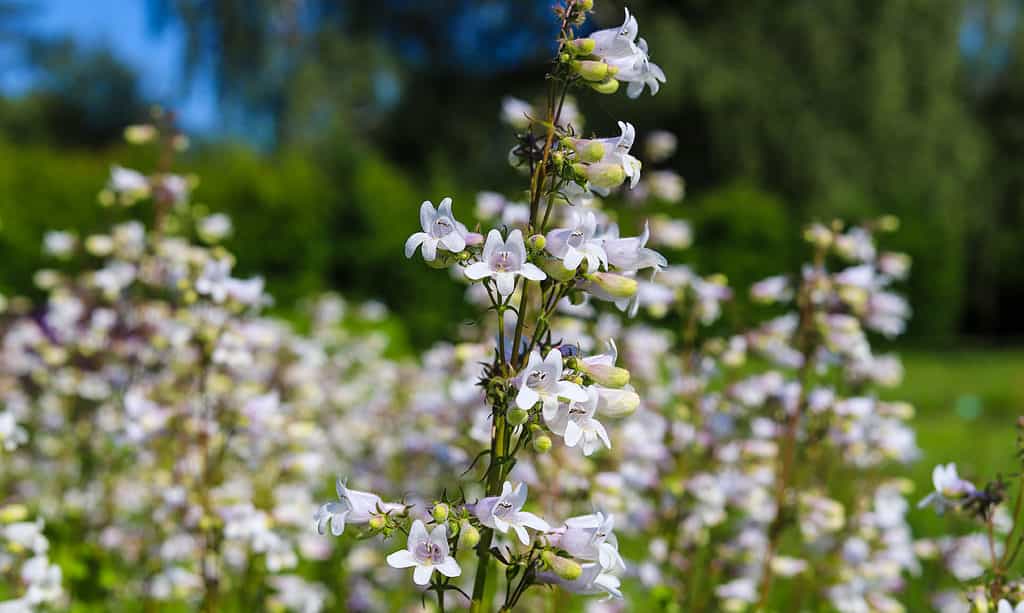
Foxglove beardtongue is a great, delicate flower to plant if you want to add a touch of elegance to your yard.
©Kabar/Shutterstock.com
4. Daisies
Who doesn’t love a good daisy? This is a classic and easily recognizable perennial cherished for its simple yet charming appearance. Its iconic white or yellow petals radiate from a cheerful, central disk, creating a delightful contrast. Daisies possess a sunny and wholesome aura, making them a symbol of purity and innocence.
Native to various regions worldwide, daisies are adaptable and can be found in meadows, grasslands, and even cultivated gardens. Their ability to thrive in a variety of soil types and their preference for full sunlight contribute to their widespread presence. In Wyoming, daisies often grace roadsides, open fields, and gardens, adding a touch of natural beauty.
Daisies have a remarkable knack for flourishing in challenging climates, making them well-suited for Wyoming’s diverse conditions. Their capacity to endure both cold winters and hot summers, along with their tolerance for well-drained soils, align with the state’s fluctuating weather patterns. Additionally, their nectar-rich blooms attract pollinators like bees and butterflies, contributing to the ecosystem’s health.
With their timeless allure and ability to brighten up spaces with a dose of simplicity, daisies have earned their place as a beloved flower in Wyoming’s landscapes. Their adaptability, resilience, and inviting appearance make them a favorite among gardeners and nature enthusiasts alike.

Daisies can grow in abundance in Wyoming due to their resilience.
©Christina Duarte/Shutterstock.com
5. Woodruff
The woodruff flower is a delicate and aromatic perennial cherished for its subtle beauty and sweet scent. With whorls of small, star-shaped white flowers, it forms dainty clusters atop slender stems. Its leaves, arranged in whorls as well, emit a pleasant hay-like fragrance when crushed.
Native to Europe and North Africa, the woodruff flower has found a hospitable home in the diverse landscapes of Wyoming. It thrives in shaded woodlands, moist meadows, and along stream banks. Its preference for partial to full shade and its ability to tolerate a range of soil types contribute to its success in the state’s varying habitats.
Wyoming’s fluctuating climate, characterized by cold winters and rapid temperature changes, aligns well with the woodruff flower’s adaptability. Its hardy nature enables it to withstand chilly conditions. Just as well, its growth in low-light environments suits Wyoming’s forested areas and shaded corners.
The woodruff flower’s capacity to provide ground cover and its subtle charm make it a popular choice for shaded gardens and natural landscapes. Its aromatic leaves also have traditional uses, such as flavoring beverages and perfumes. In Wyoming’s rugged beauty, the woodruff flower’s ability to thrive in diverse conditions and its alluring fragrance enhance its appeal to both nature enthusiasts and gardeners.
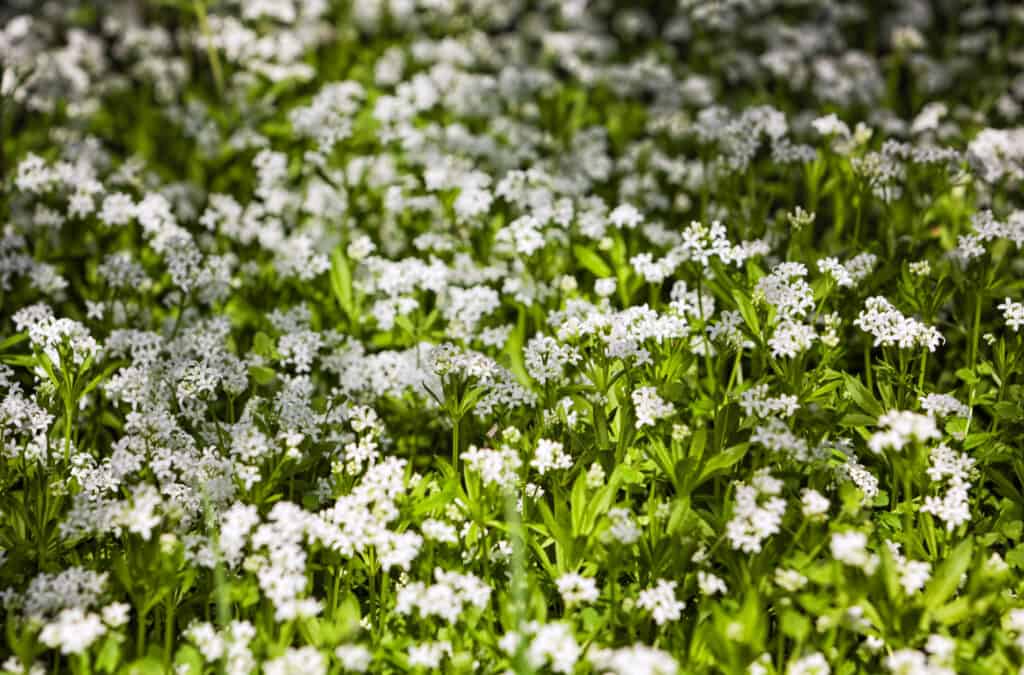
Woodruff can be found growing in the wild in some parts of the Pacific Northwest. However, they were originally native to Europe and North Africa.
©iStock.com/eyewave
6. Daylilies
The daylily flower is a vibrant perennial celebrated for its striking appearance and adaptability. With its distinctive trumpet-like shape, it showcases an array of colors including shades of orange, yellow, pink, and red. Each flower lasts only a day, but numerous buds ensure a continuous bloom period.
Originating from Asia, daylilies flourish across the landscapes of Wyoming. They thrive in various environments, from gardens and borders to roadsides and open fields. Their capability to tolerate diverse soil types, including clay and sandy soils, contributes to their widespread presence.
Wyoming’s climatic conditions, marked by cold winters and fluctuating temperatures, align favorably with the daylily’s attributes. Its hardiness enables it to withstand temperature variations, while its water-wise nature makes it well-suited for the state’s semi-arid regions.
Beyond their ornamental value, daylilies offer additional benefits such as erosion control and attracting pollinators like bees and butterflies. Their low-maintenance requirements and ability to thrive in challenging conditions make them a popular choice among gardeners seeking reliable and beautiful blooms.
In Wyoming’s diverse landscapes, the daylily’s vibrant hues and enduring nature bring a burst of color and life. Its adaptability to the state’s climate and its ornamental charm make it a cherished addition to gardens and natural settings alike.
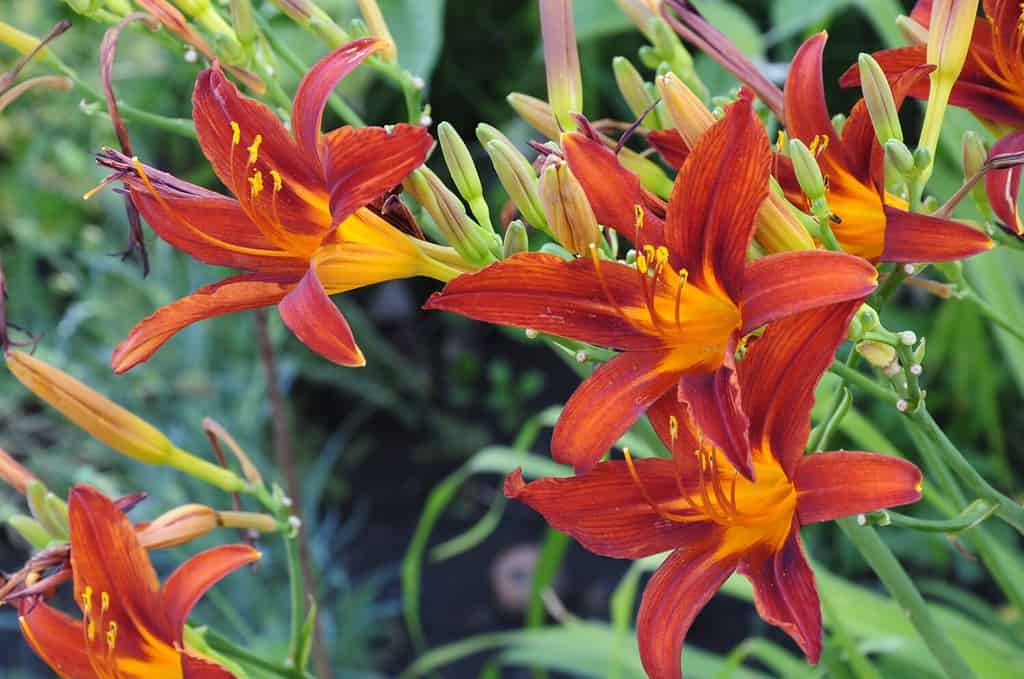
Daylilies are similar to lilies but are completely different plants.
©Fayka2008/Shutterstock.com
7. Yarrow
The yarrow flower is a resilient perennial admired for its unique appearance and practical uses. With clusters of small, flat-topped blooms, yarrow exhibits a wide spectrum of colors, including white, pink, and yellow. Its feathery, fern-like leaves contribute to its distinctive look.
Native to North America, yarrow flourishes in a variety of environments across Wyoming. It can be found in meadows, prairies, and along roadsides. Yarrow’s adaptability to different soil types and its preference for full sun make it a common sight in the state’s diverse landscapes.
Wyoming’s challenging climate, characterized by fluctuating temperatures and arid conditions, aligns well with Yarrow’s robust nature. Its drought tolerance and ability to endure both cold winters and hot summers contribute to its success in the region.
Beyond its ornamental value, yarrow has historical and medicinal significance. It’s known for attracting beneficial insects like bees and butterflies, aiding in pollination. Additionally, its leaves have been used for various purposes, including herbal remedies and as a natural insect repellent.
In Wyoming’s vast natural beauty, yarrow’s resilient and adaptable qualities shine. Its vibrant blooms, coupled with its ability to thrive in diverse conditions, make it a valued choice for both landscaping and ecological purposes.

Yarrow is known for its traditional medicinal uses.
©AngieC333/Shutterstock.com
8. Russian Sage
The Russian sage flower is a captivating perennial admired for its graceful appearance and aromatic qualities. It has slender, silvery-gray stems and abundant spikes of tiny lavender-blue flowers. Russian sage truly exudes an air of elegance and charm. Its finely cut foliage further adds to its delicate allure.
Originating from central Asia, the Russian sage thrives in the diverse landscapes of Wyoming. It can be found in gardens, borders, and open spaces. Its preference for well-drained soil and its ability to withstand both drought and poor soil conditions contribute to its success in the state’s varying environments.
The Russian sage’s adaptability to Wyoming’s challenging climate, marked by harsh winters and fluctuating temperatures, makes it a favored choice among gardeners. Its hardy nature and resistance to deer browsing make it a reliable addition to landscapes.
Aside from its ornamental value, Russian sage’s aromatic leaves release a pleasant fragrance when brushed against or crushed. This quality, along with its ability to attract pollinators like bees and butterflies, enhances its appeal in gardens.
In Wyoming’s vast and rugged beauty, the Russian sage’s delicate blooms and resilient qualities make it a valuable asset. Its ability to thrive in tough conditions and its aesthetic contributions make it a cherished choice for enhancing the state’s outdoor spaces.
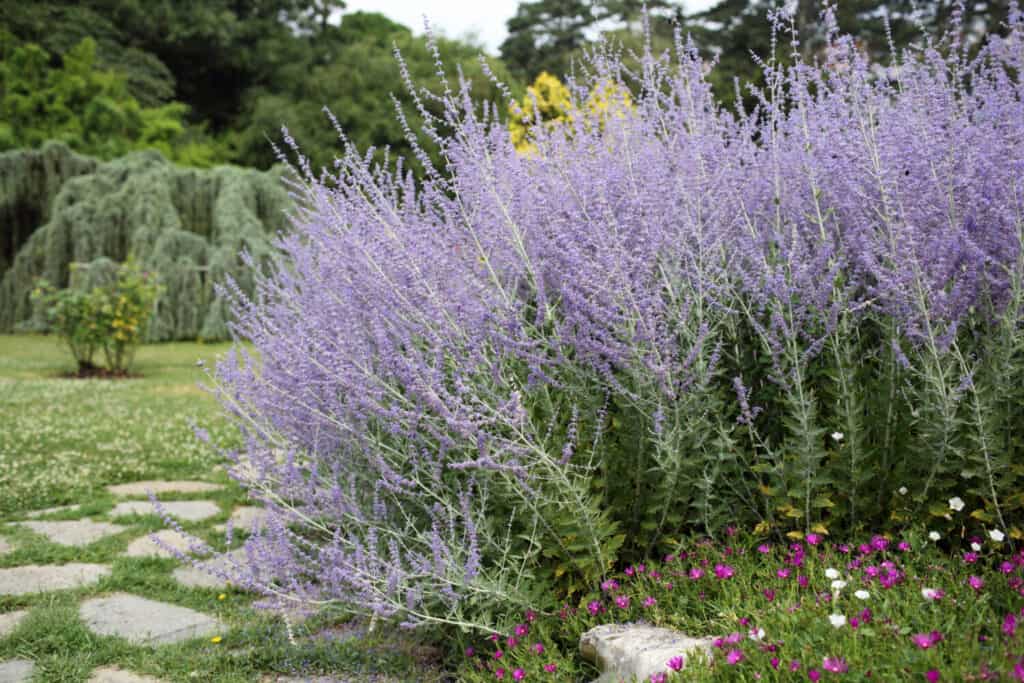
Russian sage is a lovely plant, but it can grow out of control and may not be for the novice gardener.
©loflo69/Shutterstock.com
9. Lilies
The lily flower is a captivating perennial admired for its stunning appearance and rich symbolism. It has showy, trumpet-shaped blooms. They come in an array of colors, including white, pink, orange, and red, often adorned with intricate patterns and spots. Their lush petals and prominent stamens create an alluring and vibrant display.
Lilies can be found growing in various regions around the world, and they also thrive in the landscapes of Wyoming. They flourish in well-drained soils and are often seen in gardens, borders, and even natural meadows. Their preference for full sun to partial shade suits Wyoming’s varying light conditions.
The adaptability of lilies to different soil types and their ability to tolerate cold temperatures make them well-suited for Wyoming’s climate. Their hardiness allows them to withstand both chilly winters and hot summers, contributing to their success in the region.
Beyond their ornamental appeal, lilies carry cultural and historical significance. They have been cherished for their beauty and fragrance for centuries, often symbolizing purity, renewal, and devotion. In Wyoming’s vast landscapes, the lily’s vibrant blooms and enduring nature bring a touch of elegance and symbolism, making them a cherished addition to gardens and natural settings.

While beautiful, lilies are extremely toxic to both cats and dogs, especially cats.
©iStock.com/Lastovetskiy
10. Anise Hyssop
The anise hyssop flower is a distinctive perennial with value for its unique appearance and aromatic qualities. They boast spikes of small, tubular flowers in shades of lavender, blue, or purple. This flower adds a splash of color to gardens and landscapes alike. Its textured leaves emit a pleasant scent reminiscent of anise or licorice when touched.
Originating from North America, the anise hyssop finds a welcoming habitat in Wyoming’s diverse environments. It can be spotted in meadows, prairies, and along roadsides. Its adaptability to various soil types, including sandy and well-drained soils, contributes to its successful growth in the state.
The anise hyssop’s ability to endure Wyoming’s challenging climate, characterized by temperature fluctuations and arid conditions, makes it a favored choice among gardeners. Its drought tolerance and resistance to deer browsing enhance its appeal.
Beyond its ornamental value, anise hyssop flowers are known for attracting pollinators. Such pollinators include bees and butterflies that contribute to ecosystem health. Additionally, its leaves are often in use for culinary purposes, adding a unique flavor to teas and dishes.
In Wyoming’s diverse landscapes, the anise hyssop’s distinctive blooms and versatile qualities make it a valuable addition. Its adaptability to varying conditions and its aromatic charm make it a cherished choice for gardens and natural settings alike.
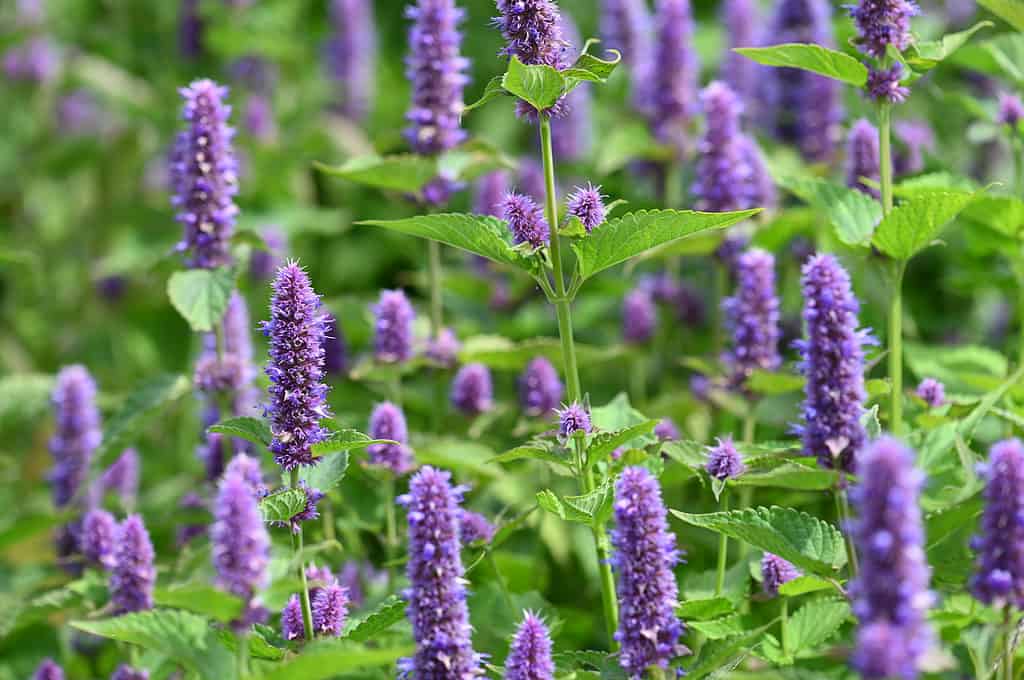
The anise hyssop is a plant in the mint family and one of the major attractions for pollinators.
©iStock.com/BethAmber
Summary of the Best Perennial Flowers to Plant in Wyoming
| # | Flower | Sunlight Needs |
|---|---|---|
| 1 | Pigsqueak | Partial to full shade |
| 2 | Periwinkle | Partial to full shade |
| 3 | Foxglove Beardtongue | Full sun to partial shade |
| 4 | Daisies | Full sun to partial shade |
| 5 | Woodruff | Partial to full shade |
| 6 | Daylilies | Full sun to partial shade |
| 7 | Yarrow | Full sun |
| 8 | Russian Sage | Full sun |
| 9 | Lilies | Full sun to partial shade (depending on the type) |
| 10 | Anise Hyssop | Full sun to partial shade |
Thank you for reading! Have some feedback for us? Contact the AZ Animals editorial team.

